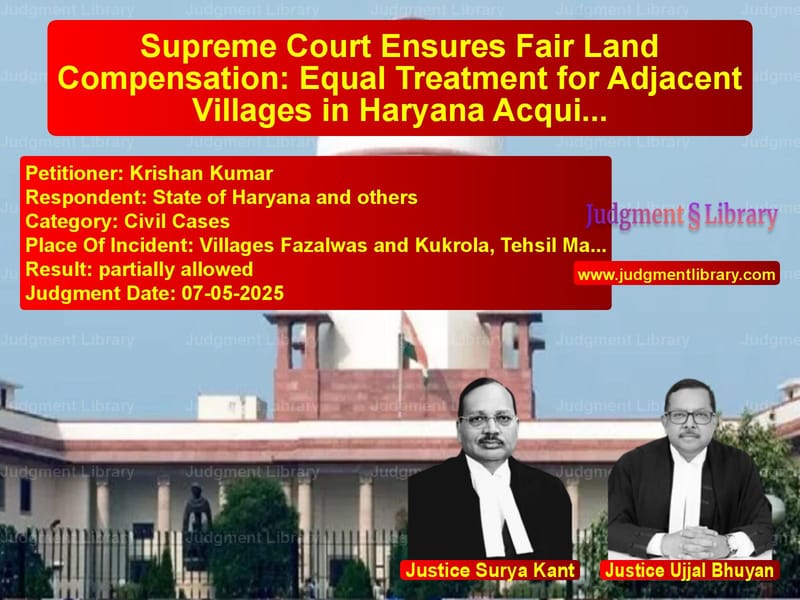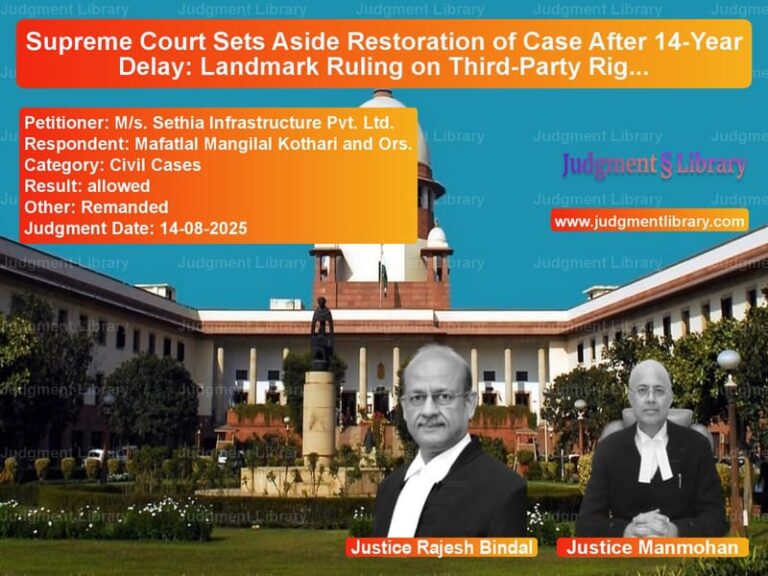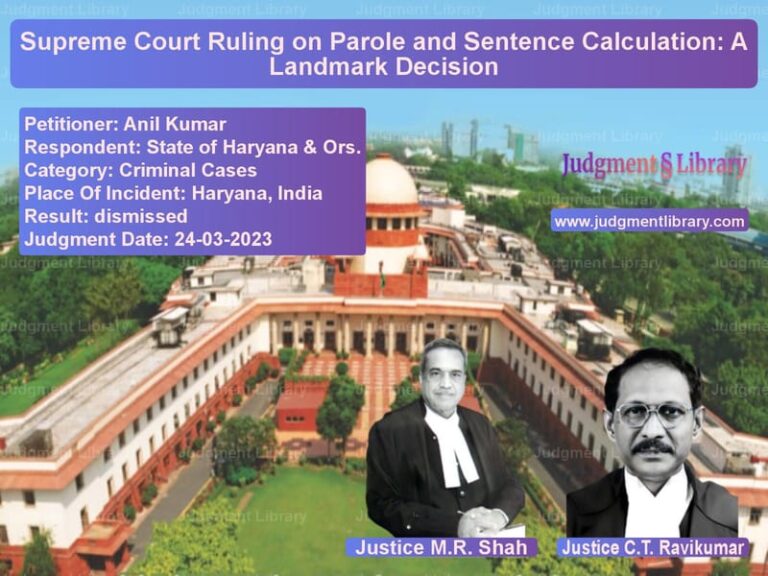Supreme Court Ensures Fair Land Compensation: Equal Treatment for Adjacent Villages in Haryana Acquisition
In a significant judgment that reinforces the principles of equality and fairness in land acquisition matters, the Supreme Court has delivered a landmark verdict ensuring that landowners from adjacent villages receive equal compensation when their lands share similar characteristics and potential. The case involving Krishan Kumar versus the State of Haryana and others represents a crucial clarification of land acquisition jurisprudence, particularly concerning the compensation standards for lands acquired for industrial development in Gurgaon district. This batch of cross-appeals brought before the Court highlighted the complex interplay between market valuation principles, geographical considerations, and the fundamental right to equal treatment under the law.
The dispute centered around the compensation awarded for lands acquired from the villages of Fazalwas and Kukrola in Tehsil Manesar, District Gurgaon, for the development of Chaudhary Devi Lal Industrial Model Township. What began as a routine land acquisition process under the Land Acquisition Act, 1894, transformed into a protracted legal battle spanning multiple judicial forums, with both landowners and the acquiring authority—Haryana State Industrial and Infrastructure Development Corporation (HSIIDC)—expressing dissatisfaction with the compensation determinations at various stages. The Supreme Court’s intervention became necessary to resolve the conflicting approaches adopted by different courts and to establish clear principles for compensation assessment in cases involving adjacent villages with similar characteristics.
The Acquisition Background and Judicial Journey
The acquisition process commenced with a notification issued on April 25, 2008, under Section 4 of the Land Acquisition Act, 1894, proposing the acquisition of approximately 3510 acres across several villages, including Fazalwas and Kukrola, for developing an integrated industrial, commercial, and public utilities complex. The Land Acquisition Collector initially determined the compensation at INR 30,00,000 per acre for both villages based on prevalent circle rates. Dissatisfied with this assessment, landowners filed reference petitions under Section 18 of the Act, leading the Reference Court to enhance the compensation to INR 62,14,421 per acre for both villages in 2013.
The matter further escalated to the Punjab and Haryana High Court, which introduced a significant modification by adopting the ‘belting method’—a technique that differentiates compensation based on proximity to major infrastructure. The High Court awarded different compensation rates for lands within 5 acres of National Highway-8 (NH-8) and those beyond this depth. Crucially, it created a disparity between the two villages, awarding INR 87,34,885 per acre for Kukrola’s inner belt lands while granting INR 1,21,00,000 per acre for Fazalwas’s similarly situated lands. This differential treatment formed the crux of the appeal before the Supreme Court.
The Landowners’ Contentions
The landowners from Kukrola vehemently argued for parity with Fazalwas, emphasizing that “the villages of Kukrola and Fazalwas are adjacent to each other and virtually indistinguishable as far as the market value of their land is concerned.” They highlighted the inconsistency in the High Court’s approach, noting that while the Reference Court and Land Acquisition Collector had treated both villages uniformly, the High Court created an artificial distinction resulting in a substantial difference of approximately INR 34,00,000 per acre for similarly situated lands.
The Kukrola landowners further contended that “although village Kukrola is more proximate to the National Capital Region than the village Fazalwas, the compensation for the land acquired in Kukrola has been unjustly assessed at a rate lower than that of Fazalwas.” They emphasized the high potentiality of their lands due to proximity to NH-8, the Kundli-Manesar-Palwal Expressway, and other approach roads, arguing that these advantages warranted compensation at par with the highest rates awarded in the region.
The Fazalwas landowners, while supporting their counterparts from Kukrola, sought further enhancement of compensation by citing additional sale exemplars and previous Supreme Court decisions that acknowledged higher escalation rates. They argued that “landowners are entitled to compensation in parlance with the highest sale transaction,” relying on the principle established in Mehrawal Khewaji Trust v. State of Punjab.
The State’s Defense
Mr. Alok Sangwan, learned Senior Additional Advocate General representing HSIIDC and the State of Haryana, vigorously defended the Land Acquisition Collector’s original award as representing just compensation. For Kukrola, he argued that the sale exemplar Ex. P-1 dated June 5, 2006—which showed a transaction at INR 73,00,000 per acre—was unreliable because “private developers generally purchase land for speculative gains by maximizing profits on an artificial market-rise.”
The State emphasized the necessity of development cuts, contending that “it is settled law that when the market value of a large tract of agriculture land is determined with reference to the sale transaction of a smaller portion of land, as in the present case, it is necessary to make deductions towards development cost to arrive at an appropriate value for the undeveloped large tracts of land.” They cited previous Supreme Court decisions where development cuts ranging from 50% to 75% had been imposed.
For Fazalwas, the State challenged the reliability of sale exemplar Ex. P-4 dated April 13, 2006, arguing that “such a sale instance should have been outrightly eliminated from consideration by the High Court” as it represented a commercial transaction that didn’t reflect the true agricultural land value.
The Supreme Court’s Analysis and Reasoning
The Supreme Court bench comprising Justice Surya Kant and Justice Ujjal Bhuyan conducted a meticulous examination of the legal principles governing compensation determination and their application to the facts of the case. The Court identified two primary issues for determination: whether the High Court erred in awarding different compensation amounts for lands acquired in Kukrola and Fazalwas, and whether the quantum of compensation awarded was appropriate.
On the first issue, the Court strongly emphasized the principle of equality, observing that “It is trite law that adjacent lands or villages possessing similar potential and advantages must be compensated equitably, unless distinctions are clearly and substantially justified.” The Court referenced its earlier decision in Land Acquisition Officer v. Karigouda, which held that “Once it is shown that situation and potential of the land in two different villages are the same then they could be awarded similar compensation or such other compensation as would be just and fair.”
The Court found no justification for the disparity created by the High Court, noting that “the lands in both villages were acquired through a common Section 4 Notification for a common purpose, namely, the establishment of the Township. It is equally incontrovertible that the lands in Kukrola and Fazalwas, which are the subject of these appeals, abut either the KMP Expressway or NH-8, and in some areas, both.”
The Court made several crucial observations about the High Court’s approach: “A fundamental principle in land acquisition jurisprudence is that lands with similar locational and developmental potential must be compensated equitably unless clear, objective distinctions justify otherwise. Neither the LAC nor the Reference Court in this case have returned any specific finding that the potential or advantages of the acquired lands in the two villages differ significantly.”
The Court further noted the inconsistency in the High Court’s reasoning: “while lands abutting NH-8 within a depth of 5 acres have been awarded markedly different rates of compensation, lands situated beyond this depth have been treated uniformly. What is particularly problematic is that the most homogeneous and comparable category—namely, the lands adjacent to NH-8—have been assessed disparately, whereas the more heterogeneous lands farther from the highway, which ostensibly vary significantly in terms of location and developmental potential, have been treated alike.”
On the second issue regarding the appropriateness of the compensation quantum, the Court endorsed the High Court’s adoption of the belting method, recognizing it as “a recognized technique in land acquisition whereby the land is divided into distinct zones based on its proximity to key infrastructural assets, such as a National Highway.” The Court found this approach justified given the large tracts of land acquired and the varying development potential based on proximity to major highways.
The Court conducted a detailed analysis of the various sale exemplars presented by both parties, applying the established principles for determining comparable sales. The Court emphasized that “the determination of compensation for compulsory acquisitions under the 1894 Act is fundamentally an exercise in equity. Rather than being a precise science, the law of compulsory acquisition in India strives to uphold the enduring principles of justice, equality, and fairness.”
Regarding the inner belt lands (those within 5 acres of NH-8), the Court agreed with the High Court’s approach in Fazalwas but extended the same principle to Kukrola to ensure parity. The Court selected sale exemplar Ex. P-2 dated April 13, 2006, as the most appropriate basis for valuation, applying a 10% annual escalation to account for the time gap between the sale and the acquisition notification. The Court rejected the State’s argument for applying a development cut to inner belt lands, reasoning that “The inner belt—comprising lands abutting NH-8 up to a depth of 5 acres—already commands a premium due to its superior locational advantage and inherent development potential. The sale exemplars for this category reflect a market value that fully incorporates these advantages.”
For the outer belt lands (those beyond 5 acres from NH-8), the Court upheld the High Court’s determination of INR 62,14,421 per acre, finding the 30% development cut and 10% escalation rate to be reasonable and supported by evidence.
The Court’s Final Ruling and Directions
In its conclusive findings, the Court established that “irrespective of whether the sale deed relied upon pertains to Kukrola or Fazalwas, the same set of exemplars must be applied uniformly across both villages. Artificial boundaries created for administrative convenience cannot be allowed to obstruct the application of the fundamental principle of fairness.”
The Court partly allowed the appeals preferred by landowners from Kukrola, modifying the High Court’s judgment with specific directions: The compensation for the outer belt lands beyond 5 acres from NH-8 was upheld at INR 62,14,421 per acre, while the compensation for inner belt lands in Kukrola was enhanced to INR 1,21,00,000 per acre, bringing it at par with Fazalwas. The appeals by Fazalwas landowners seeking further enhancement and those by HSIIDC challenging the compensation were dismissed.
This judgment represents a significant reinforcement of the principles of equality and fairness in land acquisition jurisprudence. By ensuring that similarly situated landowners receive equal compensation regardless of artificial village boundaries, the Supreme Court has strengthened the constitutional guarantee of equal treatment under the law. The decision also provides valuable guidance on the application of the belting method, the selection of comparable sale exemplars, and the appropriate circumstances for applying development cuts and escalation rates.
The ruling balances the interests of landowners, who deserve fair compensation for their acquired property, with those of the acquiring authority, which must manage public resources responsibly. By establishing clear principles for compensation determination in cases involving adjacent villages with similar characteristics, the judgment brings much-needed certainty and consistency to this complex area of law, potentially influencing future land acquisition cases across the country.
Petitioner Name: Krishan Kumar.Respondent Name: State of Haryana and others.Judgment By: Justice Surya Kant, Justice Ujjal Bhuyan.Place Of Incident: Villages Fazalwas and Kukrola, Tehsil Manesar, District Gurgaon, Haryana.Judgment Date: 07-05-2025.Result: partially allowed.
Don’t miss out on the full details! Download the complete judgment in PDF format below and gain valuable insights instantly!
Download Judgment: krishan-kumar-vs-state-of-haryana-and-supreme-court-of-india-judgment-dated-07-05-2025.pdf
Directly Download Judgment: Directly download this Judgment
See all petitions in Property Disputes
See all petitions in Damages and Compensation
See all petitions in Consumer Rights
See all petitions in Other Cases
See all petitions in Judgment by Surya Kant
See all petitions in Judgment by Ujjal Bhuyan
See all petitions in partially allowed
See all petitions in supreme court of India judgments May 2025
See all petitions in 2025 judgments
See all posts in Civil Cases Category
See all allowed petitions in Civil Cases Category
See all Dismissed petitions in Civil Cases Category
See all partially allowed petitions in Civil Cases Category







